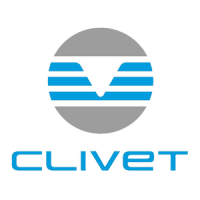9
Operate in compliance with safety regulations in force.
For detailed information (dimensions, weight, technical
characteristics etc.) please refer to the TECHNICAL
INFORMATION section.
Use single protection devices : gloves, glasses ecc.
During positioning consider these elements :
• technical spaces required for the machine and system
• place where the machine will be installed
• electrical connections
• water connections
• spaces for the air intake/exhaust
3.1 PRELIMINARY INFORMATION
A correct circulation of the air is indispensible to guarantee the
good working order of the machine.
Avoid therefore:
• obstacles to the airflow;
• exchange difficulties;
• leaves or other foreign bodies that can obstruct the
exchange batteries;
• winds that hinder or favour the airflow;
• heat or pollution sources close to the unit (chimneys,
extractors etc);
• stratification (cold air that stagnates at the bottom);
• recirculation (expelled air that is sucked in again);
• positioning below the level of the threshold, close to very
high walls, attics or in angles that could give rise to
stratification or recirculation phenomenons.
Ignoring the previous indications could:
• energy efficiency decrease;
• blocks due to HIGH PRESSURE (in summer) or LOW
PRESSURE (in winter).
3.4 EXTERNAL ENTHALPY PROBE - option
The external probe allows to automatically change the unit
setpoint according to the external enthalpy (temperature +
humidity).
In this way is not possible to optimize the unit energy
efficiency .
In the winter operating also the defrosting times are optimized.
POSITIONING
The sensor must not be influenced by factors that can cause a
false reading (for example direct sun rays, air expelled by the
fan or other sources, contact with the unit structure or other
heat sources, accumulation of snow/ice).
Example for the positioning of the external probe:
• A attic
• B Underneath a terrace
• C If attached to external wall provide a small roof
framework
3.2 FUNCTIONAL SPACES
3.3 POSITIONING
Functional spaces are designed to:
• guarantee good unit operation
• carry out maintenance operations
• protect authorized operators and exposed people
Respect all functional spaces indicated in the TECHNICAL
INFORMATION section.
Double all functional spaces if two or more unit are aligned.
Units are designed to be installed:
• EXTERNAL (accessory hoods KCUX)
• INTERNAL (accessory fan CAN)
• in fixed positions.
Choose the installation place according to the following
criteria:
• Customer approval
• safe accessible position
• technical spaces requested by the unit
• spaces for the air intake/exhaust
• max. distance allowed by the electrical connections
• control points with capacity adequate to the unit weight
• condensate water draining
Prefer places where the unit doesn't disturb the neighbours.
Avoid installations next to bedrooms or windows.
Limit vibration transmission:
• use antivibration devices on unit bearing points;
• install flexible joints on the hydraulic.
In case of installation on the ground include a raised
basement to prevent damage from flooding.
Provide a drainage channel for the condensate disposal.
3 - POSITIONING

